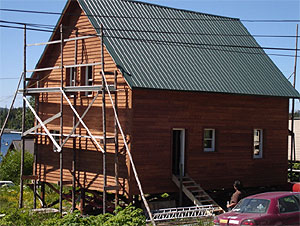 Photo: John WoodwardThere were many rude awakenings in my transition from the priesthood and life in a religious community (I was a member of the Congregation of Holy Cross, a community of priests, brothers, and sisters founded as a teaching order in France in the mid-18th Century). Religious priests, unlike diocesan priests, take a vow of poverty along with the vows of chastity and obedience that all Catholic priests take. The vow of poverty didn’t mean I was poor--it meant that I didn’t own anything. All our salaries went into a common pot, and we each took what we needed to live on, with the rest going to support our elderly members, those still in formation, and those who work among the poor. What a surprise that the rest of the country doesn’t operate that way!
Photo: John WoodwardThere were many rude awakenings in my transition from the priesthood and life in a religious community (I was a member of the Congregation of Holy Cross, a community of priests, brothers, and sisters founded as a teaching order in France in the mid-18th Century). Religious priests, unlike diocesan priests, take a vow of poverty along with the vows of chastity and obedience that all Catholic priests take. The vow of poverty didn’t mean I was poor--it meant that I didn’t own anything. All our salaries went into a common pot, and we each took what we needed to live on, with the rest going to support our elderly members, those still in formation, and those who work among the poor. What a surprise that the rest of the country doesn’t operate that way!
For going on seven years now, I have been writing and editing articles about energy efficient, healthy, sustainable, and affordable housing, while living in an area with about the most expensive housing in the world. Early on at Home Energy magazine, I reviewed a book by a Berkeley author and homeowner about his "green" home. The control system for his HVAC, lights, and windows uses more energy than most people use to heat and cool their homes. According to a recent survey in Natural Home magazine, the most popular green retrofit is installing photovoltaic panels--not replacing inefficient appliances, switching out incandescent lights for CFLs, or adding some insulation in the attic, all affordable and cost-effective measures. I find myself at the center of the green building movement and unable to participate except from the sidelines!
That may change. My wife and I just made our ninth offer on a house--a small home in Walnut Creek. (We were outbid on our first offer, about a year ago, for a small home in Oakland, by $100,000.) We went to bed last night with our fingers crossed--made it kind of hard to snuggle.
I don’t know the answer to the problem of making well-built homes affordable for everyone. The substantial federal tax breaks that homeowners receive benefit mostly the middle and upper classes. Habitat for Humanity, with its reliance on “sweat equity” is a great model, but their aren’t nearly enough Habitat chapters in the country to make a dent in the problem. Communism, outside the version I lived as a religious priest, has proven impractical. Do you think I could convince everyone in California to take a vow of poverty?
![]() Jim Gunshinan is Managing Editor of Home Energy Magazine. He holds an M.S. in Bioengineering from Pennsylvania State University, State College, Pennsylvania, and a Master of Divinity (MDiv) degree from University of Notre Dame.
Jim Gunshinan is Managing Editor of Home Energy Magazine. He holds an M.S. in Bioengineering from Pennsylvania State University, State College, Pennsylvania, and a Master of Divinity (MDiv) degree from University of Notre Dame.
